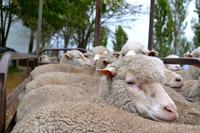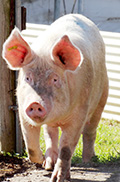Current projects
Semen preservation, artificial insemination and embryo transfer in sheep

The group is responsible for the development and application of most artificial breeding techniques currently employed in the Australian sheep industry. Technology transfer is continuing through undergraduate/postgraduate teaching and industry training.
Current work focuses on utilising state-of-the-art proteomic techniques and novel in vivo cell imaging systems to investigate the interaction between ram spermatozoa, seminal plasma and the ewe’s reproductive tract. The goal of this research is to improve the fertility of frozen-thawed ram semen delivered by AI, with particular emphasis placed on improving the transit of frozen-thawed spermatozoa through the female genital tract.
Development of assisted reproductive technologies
Our group is actively developing and refining a broad suite of assisted reproductive technologies (ARTs) to support both livestock production and wildlife conservation. These include sperm sexing, artificial insemination (AI), in vitro fertilisation (IVF), embryo transfer (ET), multiple ovulation and embryo transfer (MOET), and ovum pick-up (OPU). Our aim is to enhance genetic gain, reproductive efficiency, and access to high-value genetics across a range of animal species.
In vitro prediction of fertility
We are developing and validating in vitro tools to predict fertility before breeding. These include advanced semen analyses (including morphology, motility, and functional assays), assessments of female reproductive status, and environmental condition monitoring. We are also integrating omics technologies—such as transcriptomics and proteomics—to identify molecular markers of fertility and build more accurate, multi-factorial predictive models.
Sperm metabolism and semen storage technologies
We are exploring sperm metabolism to identify the cellular and molecular pathways that support sperm function during storage. This work informs the development of improved extenders, cryoprotectants, and storage protocols—both chilled and frozen—that preserve sperm viability and enhance fertility after thawing.
Sperm-female tract interactions and fertility outcomes
We use advanced proteomic and in vivo imaging techniques to investigate how ram spermatozoa and seminal plasma interact with the ewe’s reproductive tract. These studies aim to uncover mechanisms that influence sperm transport, survival, and fertilisation success, ultimately improving outcomes with frozen-thawed semen in artificial insemination programs.
Precision monitoring of reproductive state via development of pen side mucus testing and continuous remote monitoring in pigs

Detecting sow reproductive state more efficiently and effectively is a current priority for the pig industry. This project will investigate real time markers of the reproductive state of sows and gilts, specifically looking to identify oestrus and ovulation, pregnancy earlier than 28-days post-insemination and to predict the onset of parturition. The major focus of these three arms will be characterising changes in cervical mucus throughout the reproductive stages. Detecting changes in cervical mucus will lead to the development of accurate real-time, pen-side tests that are non-invasive and easy to use, so transforming the way pigs are managed.
This project is a partnership with South Australian Research and Development Institute (SARDI) and SunPork Solutions.
Machine learning for reproductive diangostics
We apply machine learning and artificial intelligence to develop next-generation reproductive diagnostics. This includes automated assessment of sperm morphology and motility, predictive models for pregnancy detection in sheep, and sensor-based monitoring of reproductive events in real time. These tools aim to improve decision-making, precision management, and reproductive efficiency across species.
